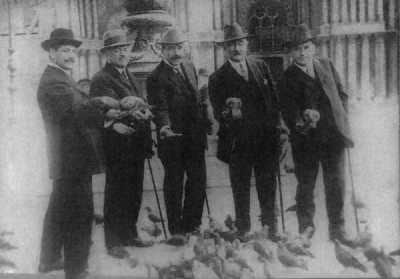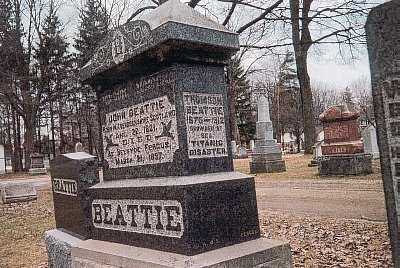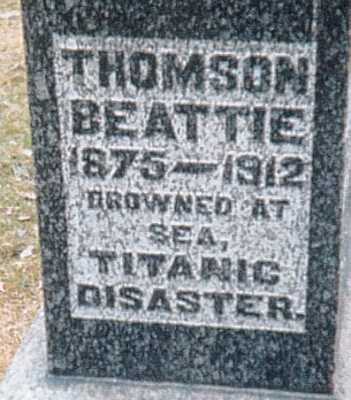Mr Thomson Beattie was born on 25 November 1875, late in his mother's life in Fergus, Ontario, a small but thriving rural community 100 km west of Toronto. He was the last of eleven children in a solid, conservative Presbyterian family, and was 24 years younger than his eldest brother, William. His father was a private banker, and in 1871 was named the Clerk of Wellington County, a position he held until his death in 1897.
After their father died, Thomson and his brother, Charles, took their share of the estate and moved to Winnipeg, Manitoba. There Thomson went into partnership with Richard Waugh, and together they opened the Haslam Land Co. Within five years their enterprise was so successful, Beattie was able to buy a substantial house that he shared with a medical doctor in an upscale neighbourhood, at 560 River Ave. When Waugh was elected Mayor of Winnipeg in 1911, Beattie was left to run their company on his own. His best friend and closest companion was Thomas McCaffry, the superintendant of the Union Bank in Vancouver. The Winnipeg Free Press described the men as "almost inseparable."
In January 1912, Beattie, McCaffry and another friend, John Hugo Ross, sailed from New York to Trieste on the Franconia for a winter vacation. By March, Ross had become ill and Beattie and McCaffry, too were exhausted from their travels. They decided to sail home on Titanic. "We are changing ships and coming home in a new, unsinkable boat," Beattie wrote to his mother three days before they sailed.

(Courtesy: Alan Hustak, Canada)
Beattie paid £75 4s 10d for first-class cabin C-6 (ticket number 13050), which he shared with McCaffry. Beattie must have been on the roof near the officer's quarters, near the last available life raft, Collapsible A when the ship went down. He scrambled aboard, made it into the boat, but died of exposure. When Harold Lowe emptied the boat, there were three bodies, including Beattie's left behind.
A full month after the disaster, the Oceanic came across the boat bobbing in the open sea at 47 degrees, 10 minutes N, 30 degrees, 56 minutes W, some 300 km southeast of where Titanic had gone down. Sir Shane Leslie, who was aboard the Oceanic, recalled
"the sea was calm at noon when the watch called out that something could be seen floating ahead. The ship slowed down and it was apparent that the object was an open ship's lifeboat floating in mid Atlantic. What was horrifying is that it contained three prostrate figures. Orders from the bridge dispatched a lifeboat with an officer and a medical officer. What followed was ghastly. Two sailors could be seen, their hair bleached by exposure to sun and salt, and a third figure, wearing evening dress, flat on the benches. All three were dead and the bodies had been tossing on the Atlantic swell under the open sky ever since it had seen the greatest of ocean liners sink. The three bodies were sewn into canvas bags with a steel bar at the end of each. Then one after the other the bodies were draped in the Union Jack, the burial service was read, and they splashed into the sea."
In a phenomenal example of what might be called cosmic serendipity, Beattie's body was buried at sea on his mother's birthday, almost at the same spot in the Atlantic where she had been born 82 years earlier on a ship bound for Canada.
He is remembered on a stone in the family plot in Fergus, Ontario.




Comment and discuss
-
Any informaton about relatives in Canada or elsewhere, information about parents, etc. I believe that my great grandmother (Beattie) was related to Thomson Beattie. Linda White
-
Thomson Beattie’s will, dated 18 December 1906, appointed the National Trust Company Limited as executor of his estate. This will and various Surrogate Court papers are contained within the Manitoba Probate Records, 1871-1930, Eastern, Estate files no 6699-6838, years 1912. Located amongst these (page 1538, attached here) is a statement of account, which makes a curious reference to “the Action by the Executors on behalf of Janet Beattie against Oceanic Steam Ship Company”. (Thomson’s mother Janet was one of the 15 beneficiaries of his will). On 28 November 1913, $97.35 was paid to Black & Redden (English solicitors) for “fees re Titanic action. On 2 April 1916, $1729.26 was received from Hudson, Ormond & Company (Beattie’s solicitors) “in full settlement of Action.” The timing of this payment suggests that it could have been part of the $664,000 class-action settlement agreed to in December 1915. Does anyone have any information?

Open Thread Leave a Reply